《信号与系统》课程教学大纲 Signals and Systems
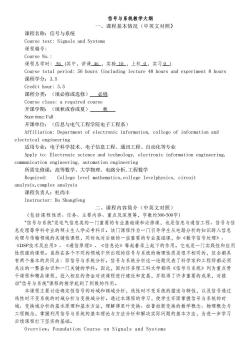
信号与系统教学大纲一、课程基本情况(中英文对照)课程名称:信号与系统Course text: Signals and Systems课程编号:Course No. :课程总学时:56(其中,讲课_46,实验_10,上机,实习0)Course total period: 56 hours (including lecture 48 hours and experiment 8 hours课程学分:3.5Credit hour: 3.5课程分类:(填必修或选修)必修Course class: a required course开课学期:(填秋或春或夏)秋Start time: Fall开课单位:(信息与电气工程学院电子工程系)Affiliation: Department of electronic information, college of information andelectrical engineering适用专业:电子科学技术、电子信息工程、通讯工程、自动化等专业Apply to: Electronic science and technology, electronic information engineeringcommunication engineering, automation engineering所需先修课:高等数学、大学物理、电路分析,工程数学Required:College level mathematics,college levelphysics, circuitanalysis, complex analysis课程负责人:杜尚丰Instructor: Du Shangfeng二、课程内容简介(中英文对照)(包括课程性质、任务、主要内容、重点及深度等,字数约300-500字)"信号与系统"是电气信息类的一门重要的专业基础课和必修课,也是信息与通信工程、信号与信息处理等学科专业的硕士生人学必考科目。该门课程作为一门引导学生从电路分析的知识跨入信息处理与传输领域的关键性课程,同时也对后继的一些重要的专业基础课,如《数字信号处理》《DSP技术及应用》、《通信原理》、《信息论》等起着承上起下的作用。它也是一门实践性和应用性很强的课程。虽然在各个不同的领域中所出现的信号与系统的物理性质是很不相同的,但全都具有两个基本的共同点:即信号与系统分析。信号与系统分析这一论题代表了科学家和工程师都必须关注的一整套知识和一门关键的学科。因此,国内许多理工科大学都将《信号与系统》列为重点骨干课程和精品课程,投入相应的资金对该课程进行建设和发展,并取得了许多重要的成果,对推动"信号与系统"课程的教学起到了积极的作用。本课程主要讨论确定性信号的时域和频域分析,线性时不变系统的描述与特性,以及信号通过线性时不变系统的时域分析与变换域分析。通过本课程的学习,使学生牢固掌握信号与系统的时域、变换域分析的基本原理和基本方法,理解傅里叶变换、拉普拉斯变换的数学概念、物理概念与工程概念,掌握利用信号与系统的基本理论与方法分析和解决实际问题的基本方法,为进一步学习后续课程打下坚实的基础。Overview: Foundation Course on Signals and Systems
信号与系统教学大纲 一、课程基本情况(中英文对照) 课程名称:信号与系统 Course text: Signals and Systems 课程编号: Course No.: 课程总学时: 56 (其中,讲课 46 ,实验 10 ,上机 0 ,实习 0 ) Course total period: 56 hours (including lecture 48 hours and experiment 8 hours 课程学分:3.5 Credit hour: 3.5 课程分类:(填必修或选修) 必修 Course class: a required course 开课学期:(填秋或春或夏) 秋 Start time: Fall 开课单位:(信息与电气工程学院电子工程系) Affiliation: Department of electronic information, college of information and electrical engineering 适用专业:电子科学技术、电子信息工程、通讯工程、自动化等专业 Apply to: Electronic science and technology, electronic information engineering, communication engineering, automation engineering 所需先修课:高等数学、大学物理、电路分析,工程数学 Required: College level mathematics,college levelphysics, circuit analysis,complex analysis 课程负责人:杜尚丰 Instructor: Du Shangfeng 二、课程内容简介(中英文对照) (包括课程性质、任务、主要内容、重点及深度等,字数约300-500字) "信号与系统"是电气信息类的一门重要的专业基础课和必修课,也是信息与通信工程、信号与信 息处理等学科专业的硕士生人学必考科目。该门课程作为一门引导学生从电路分析的知识跨入信息 处理与传输领域的关键性课程,同时也对后继的一些重要的专业基础课,如《数字信号处理》、 《DSP技术及应用》、《通信原理》、《信息论》等起着承上起下的作用。它也是一门实践性和应用 性很强的课程。虽然在各个不同的领域中所出现的信号与系统的物理性质是很不相同的,但全都具 有两个基本的共同点:即信号与系统分析。信号与系统分析这一论题代表了科学家和工程师都必须 关注的一整套知识和一门关键的学科。因此,国内许多理工科大学都将《信号与系统》列为重点骨 干课程和精品课程,投入相应的资金对该课程进行建设和发展,并取得了许多重要的成果,对推 动"信号与系统"课程的教学起到了积极的作用。 本课程主要讨论确定性信号的时域和频域分析,线性时不变系统的描述与特性,以及信号通过 线性时不变系统的时域分析与变换域分析。通过本课程的学习,使学生牢固掌握信号与系统的时 域、变换域分析的基本原理和基本方法,理解傅里叶变换、拉普拉斯变换的数学概念、物理概念与 工程概念,掌握利用信号与系统的基本理论与方法分析和解决实际问题的基本方法,为进一步学习 后续课程打下坚实的基础。 Overview:Foundation Course on Signals and Systems
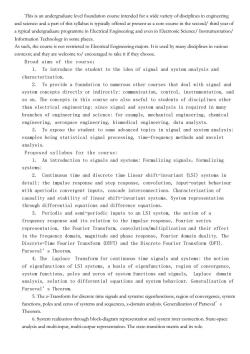
This is an undergraduate level foundation course intended for a wide variety of disciplines in engineeringandscienandaarthissylabusisypiallyofferedatpresentasorcoursinhesccondthirdyearofa typical undergraduate programme in Electrical Engineering, and even in Electronic Science/ Instrumentation/Information Technology in some placesAs such,thecourseisnotrestricted toElectricalEngineeringmajors.Itis usedbymanydisciplines invariouscontexts; and they are welcome to/ encouraged to take it if they chooseBroad aims of the course:To introduce the student to the idea of signal and system analysis andcharacterization.To provide a foundation to numerous other courses that deal with signal andsystem concepts directly or indirectly: communication, control, instrumentation, andso on. The concepts in this course are also useful to students of disciplines otherthan electrical engineering; since signal and system analysis is required in manybranches of engineering and science: for example, mechanical engineering, chemicalengineering, aerospace engineering, biomedical engineering, data analysts.To expose the student to some advanced topics in signal and system analysis:examples being statistical signal processing, time-frequency methods and waveletanalysis.Proposed syllabus for the course:An introduction to signals and systems: Formalizing signals, formalizingsystems:Continuous time and discrete time Linear shift-invariant (LSI) systems indetail: the impulse response and step response, convolution, input-output behaviourwith aperiodic convergent inputs, cascade interconnections. Characterization ofcausality and stability of linear shift-invariant systems.System representationthrough differential equations and difference equations.Periodic and semi-periodic inputs to an LsI system,the notion of afrequency response and its relation to the impulse response, Fourier seriesrepresentation, the Fourier Transform, convolution/multiplication and their effectin the frequency domain, magnitude and phase response, Fourier domain duality. TheDiscrete-Time Fourier Transform (DTFT) and the Discrete Fourier Transform (DFT)Parseval's Theorem4. The Laplace Transform for continuous time signals and systems: the notionof eigenfunctions of LSI systems, a basis of eigenfunctions, region of convergence,system functionsLaplace domainpoles and zeros of system functions and signals,analysis, solution to differential equations and system behaviour. Generalization ofParseval's Theore5.The z-Transform for discrete time signals and systems: cigenfunctions, region ofconvergence, systemfunionesandzytemandsqumainaalyGaizanarsalTheorem.SystemrealizationthoughbokdiagramrpresentaionandsysteminernnctionStatpaanalysisandmulti-input,multi-outputrepresentation.Thestate-transitionmatrix and itsrole
This is an undergraduate level foundation course intended for a wide variety of disciplines in engineering and science: and a part of this syllabus is typically offered at present as a core course in the second/ third year of a typical undergraduate programme in Electrical Engineering; and even in Electronic Science/ Instrumentation/ Information Technology in some places. As such, the course is not restricted to Electrical Engineering majors. It is used by many disciplines in various contexts; and they are welcome to/ encouraged to take it if they choose. Broad aims of the course: 1. To introduce the student to the idea of signal and system analysis and characterization. 2. To provide a foundation to numerous other courses that deal with signal and system concepts directly or indirectly: communication, control, instrumentation, and so on. The concepts in this course are also useful to students of disciplines other than electrical engineering; since signal and system analysis is required in many branches of engineering and science: for example, mechanical engineering, chemical engineering, aerospace engineering, biomedical engineering, data analysts. 3. To expose the student to some advanced topics in signal and system analysis: examples being statistical signal processing, time-frequency methods and wavelet analysis. Proposed syllabus for the course: 1. An introduction to signals and systems: Formalizing signals,formalizing systems: 2. Continuous time and discrete time Linear shift-invariant (LSI) systems in detail: the impulse response and step response, convolution, input-output behaviour with aperiodic convergent inputs, cascade interconnections. Characterization of causality and stability of linear shift-invariant systems. System representation through differential equations and difference equations. 3. Periodic and semi-periodic inputs to an LSI system, the notion of a frequency response and its relation to the impulse response, Fourier series representation, the Fourier Transform, convolution/multiplication and their effect in the frequency domain, magnitude and phase response, Fourier domain duality. The Discrete-Time Fourier Transform (DTFT) and the Discrete Fourier Transform (DFT). Parseval’s Theorem. 4. The Laplace Transform for continuous time signals and systems: the notion of eigenfunctions of LSI systems, a basis of eigenfunctions, region of convergence, system functions, poles and zeros of system functions and signals, Laplace domain analysis, solution to differential equations and system behaviour. Generalization of Parseval’s Theorem. 5. The z-Transform for discrete time signals and systems: eigenfunctions, region of convergence, system functions, poles and zeros of systems and sequences, z-domain analysis. Generalization of Parseval’s Theorem. 6. System realization through block-diagram representation and system inter connection. State-space analysis and multi-input, multi-output representation. The state-transition matrix and its role
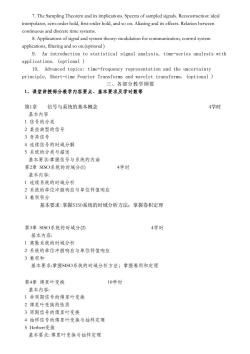
7. The Sampling Theorem and its implications. Spectra of sampled signals. Reconstruction idealinterpolator, zero-order hold, first-order hold, and so on. Aliasing and its effects. Relation betweercontinuous and discrete time system8. Applications of signal and system theory: modulation for communication, control systemapplications, filtering and so on.(optional)9.An introduction to statistical signal analysis, time-series analysis withapplications. (optional)1o.Advanced topics: time-frequency representation and the uncertaintyprinciple, Short-time Fourier Transforms and wavelet transforms. (optional )三、各部分教学纲要1、课堂讲授部分教学内容要点、基本要求及学时数等第1章信号与系统的基本概念4学时基本内容1信号的分类2某些典型的信号3奇异信号4连续信号的时域分解5系统的分类与描述基本要求:掌握信号与系统的内涵4学时第2章 SISO系统的时域分(1)基本内容:1 连续系统的时域分析2系统的单位冲激响应与单位样值响应3卷积积分基本要求:掌握SISO系统的时域分析方法;掌握卷积定理4学时第3章 SISO系统的时域分(2)基本内容:1离散系统的时域分析2系统的单位冲激响应与单位样值响应3卷积和基本要求:掌握SISO系统的时域分析方法;掌握卷积和定理第4章傅里叶变换10学时基本内容:1非周期信号的傅里叶变换2傅里叶变换的性质3周期信号的傅里叶变换4抽样信号的傅里叶变换与抽样定理5 Herbert变换基本要求:傅里叶变换与抽样定理
7. The Sampling Theorem and its implications. Spectra of sampled signals. Reconstruction: ideal interpolator, zero-order hold, first-order hold, and so on. Aliasing and its effects. Relation between continuous and discrete time systems. 8. Applications of signal and system theory: modulation for communication, control system applications, filtering and so on.(optional ) 9. An introduction to statistical signal analysis, time-series analysis with applications. (optional ) 10. Advanced topics: time-frequency representation and the uncertainty principle, Short-time Fourier Transforms and wavelet transforms. (optional ) 三、各部分教学纲要 1、课堂讲授部分教学内容要点、基本要求及学时数等 第1章 信号与系统的基本概念 4学时 基本内容 1 信号的分类 2 某些典型的信号 3 奇异信号 4 连续信号的时域分解 5 系统的分类与描述 基本要求:掌握信号与系统的内涵 第2章 SISO系统的时域分(1) 4学时 基本内容: 1 连续系统的时域分析 2 系统的单位冲激响应与单位样值响应 3 卷积积分 基本要求:掌握SISO系统的时域分析方法;掌握卷积定理 第3章 SISO系统的时域分(2) 4学时 基本内容: 1 离散系统的时域分析 2 系统的单位冲激响应与单位样值响应 3 卷积和 基本要求:掌握SISO系统的时域分析方法;掌握卷积和定理 第4章 傅里叶变换 10学时 基本内容: 1 非周期信号的傅里叶变换 2 傅里叶变换的性质 3 周期信号的傅里叶变换 4 抽样信号的傅里叶变换与抽样定理 5 Herbert变换 基本要求: 傅里叶变换与抽样定理
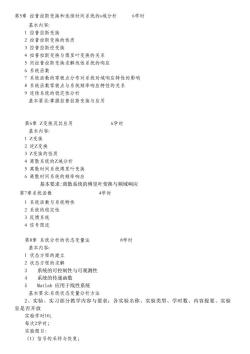
第5章拉普拉斯变换和连续时间系统的s域分析6学时基本内容:1拉普拉斯变换2拉普拉斯变换的性质3拉普拉斯逆变换4拉普拉斯变换与傅里叶变换的关系5用拉普拉斯变换求解线性系统的响应6系统函数7系统函数的零极点分布对系统时域响应特性的影响8系统函数零极点与系统频率响应特性的关系9连续系统的稳定性分析基本要求:掌握拉普拉斯变换与应用第6章Z变换及其应用6学时基本内容:1Z变换2逆Z变换3Z变换的性质4离散系统的Z域分析5离散时间系统傅里叶变换6离散时间系统的频率响应基本要求:离散系统的傅里叶变换与频域响应第7章系统函数4学时1 系统函数与系统特性2系统的稳定性3反馈系统4信号图流第8章系统分析的状态变量法8学时基本内容:1 状态方程的建立2状态方程的求解系统的可控制性与可观测性系统的传递函数4Matlab应用于线性系统基本要求:系统状态变量分析方法2、实验、实习部分教学内容与要求:各实验名称、实验类型、学时数、内容提要、实验室是否开放实验学时10;每次2学时;实验题目:(1)信号的采样与恢复;
第5章 拉普拉斯变换和连续时间系统的s域分析 6学时 基本内容: 1 拉普拉斯变换 2 拉普拉斯变换的性质 3 拉普拉斯逆变换 4 拉普拉斯变换与傅里叶变换的关系 5 用拉普拉斯变换求解线性系统的响应 6 系统函数 7 系统函数的零极点分布对系统时域响应特性的影响 8 系统函数零极点与系统频率响应特性的关系 9 连续系统的稳定性分析 基本要求:掌握拉普拉斯变换与应用 第6章 Z变换及其应用 6学时 基本内容: 1 Z变换 2 逆Z变换 3 Z变换的性质 4 离散系统的Z域分析 5 离散时间系统傅里叶变换 6 离散时间系统的频率响应 基本要求:离散系统的傅里叶变换与频域响应 第7章系统函数 4学时 1 系统函数与系统特性 2 系统的稳定性 3 反馈系统 4 信号图流 第8章 系统分析的状态变量法 8学时 基本内容: 1 状态方程的建立 2 状态方程的求解 3 系统的可控制性与可观测性 4 系统的传递函数 5 Matlab 应用于线性系统 基本要求:系统状态变量分析方法 2、实验、实习部分教学内容与要求:各实验名称、实验类型、学时数、内容提要、实验 室是否开放 实验学时10; 每次2学时; 实验题目: (1)信号的采样与恢复;
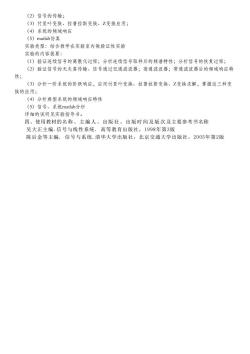
(2)信号的传输;(3)付里叶变换、拉普拉斯变换、Z变换应用;(4)系统的频域响应(5)matlab仿真实验类型:结合教学在实验室内做验证性实验实验的内容提要:(1)验证连续信号的离散化过程;分析连续信号取样后的频谱特性;分析信号的恢复过程;(2)验证信号的无失真传输、信号通过低通滤波器;高通滤波器;带通滤波器后的频域响应特性;(3)分析一阶系统的阶跃响应,应用付里叶变换、拉普拉斯变换、乙变换求解,掌握这三种变换的应用;(4)分析典型系统的频域响应特性(5)信号、系统matlab分析详细的说明见实验指导书。四、使用教材的名称、主编人、出版社、出版时间及版次及主要参考书名称吴大正主编.信号与线性系统.高等教育出版社,1998年第3版陈后金等主编:信号与系统.清华大学出版社,北京交通大学出版社,2005年第2版
(2)信号的传输; (3)付里叶变换、拉普拉斯变换、Z变换应用; (4)系统的频域响应 (5)matlab仿真 实验类型:结合教学在实验室内做验证性实验 实验的内容提要: (1)验证连续信号的离散化过程;分析连续信号取样后的频谱特性;分析信号的恢复过程; (2)验证信号的无失真传输、信号通过低通滤波器;高通滤波器;带通滤波器后的频域响应特 性; (3)分析一阶系统的阶跃响应,应用付里叶变换、拉普拉斯变换、Z变换求解,掌握这三种变 换的应用; (4)分析典型系统的频域响应特性 (5)信号、系统matlab分析 详细的说明见实验指导书。 四、使用教材的名称、主编人、出版社、出版时间及版次及主要参考书名称 吴大正主编.信号与线性系统. 高等教育出版社,1998年第3版 陈后金等主编. 信号与系统.清华大学出版社,北京交通大学出版社,2005年第2版
按次数下载不扣除下载券;
注册用户24小时内重复下载只扣除一次;
顺序:VIP每日次数-->可用次数-->下载券;
- 《电路》课程教学资源(PPT课件)第18章 分布参数的电路.ppt
- 《电路》课程教学资源(PPT课件)第17章 非线性电路.ppt
- 《电路》课程教学资源(PPT课件)第16章 二端口网络.ppt
- 《电路》课程教学资源(PPT课件)第15章 电路方程的矩阵形式.ppt
- 《电路》课程教学资源(PPT课件)第14章 网络函数.ppt
- 《电路》课程教学资源(PPT课件)第13章 拉普拉斯变换.ppt
- 《电路》课程教学资源(PPT课件)第12章 非正弦周期电流电路和信号的频谱.ppt
- 《电路》课程教学资源(PPT课件)第11章 三相电路.ppt
- 《电路》课程教学资源(PPT课件)第10章 含有耦合电感的电路.ppt
- 《电路》课程教学资源(PPT课件)第9章 正弦稳态电路的分析.ppt
- 《电路》课程教学资源(PPT课件)第8章 相量法.ppt
- 《电路》课程教学资源(PPT课件)第7章 二阶电路.ppt
- 《电路》课程教学资源(PPT课件)第6章 一阶电路(电路的过渡过程).ppt
- 《电路》课程教学资源(PPT课件)第5章 含有运算放大器的电阻电路.ppt
- 《电路》课程教学资源(PPT课件)第4章 电路定理(Circuit Theorems).ppt
- 《电路》课程教学资源(PPT课件)第3章 电阻电路的一般分析.ppt
- 《电路》课程教学资源(PPT课件)第2章 电阻电路的等效变换.ppt
- 《电路》课程教学资源(PPT课件)第1章 电路的基本概念和基本定律(电路模型和电路定律).ppt
- 《电路》课程教学资源(实验指导)实验20 电路矩阵方程的计算机求解.doc
- 《电路》课程教学资源(实验指导)实验19 非正弦周期信号电路的仿真.doc
- 《信号与系统》课程授课教案(课件讲稿)第3章 离散系统的时域分析.pdf
- 《信号与系统》课程授课教案(课件讲稿)第1章 信号与系统.pdf
- 《信号与系统》课程授课教案(课件讲稿)第2章 连续系统的时域分析.pdf
- 《信号与系统》课程授课教案(课件讲稿)第4章 连续系统的频域分析.pdf
- 《信号与系统》课程授课教案(课件讲稿)第7章 系统函数.pdf
- 《信号与系统》课程授课教案(课件讲稿)第5章 连续系统的S域分析.pdf
- 《信号与系统》课程授课教案(课件讲稿)第6章 离散系统的Z域变换.pdf
- 《信号与系统》课程教学课件(讲义)信号与系统实验指导书(共八个实验).pdf
- 《信号与系统》课程授课教案(课件讲稿)第8章 系统状态变量分析.pdf
- 《信号与系统》课程教学资源(习题解答)第二章 连续时间系统的时域分析.pdf
- 《信号与系统》课程教学资源(习题解答)第一章 信号与系统概述.pdf
- 《信号与系统》课程教学资源(习题解答)第三章 离散时间系统的时域分析.pdf
- 《信号与系统》课程教学资源(习题解答)第四章 连续信号的傅利叶分析.pdf
- 《信号与系统》课程教学资源(习题解答)第七章 连续时间系统的S域分析.pdf
- 《信号与系统》课程教学资源(习题解答)第六章 变换与离散系统的z域分析.pdf
- 《信号与系统》课程教学资源(习题解答)第五章 拉普拉斯变换与系统分析.pdf
- 《信号与系统》课程教学资源(习题解答)第八章 状态方程与状态变量分析法.pdf
- 《数字电子技术》课程教学大纲(Digital Electronics).pdf
- 《数字电子技术》课程授课教案.doc
- 《机械测试技术基础》课程教学大纲 Mechanical Test Technology.pdf
